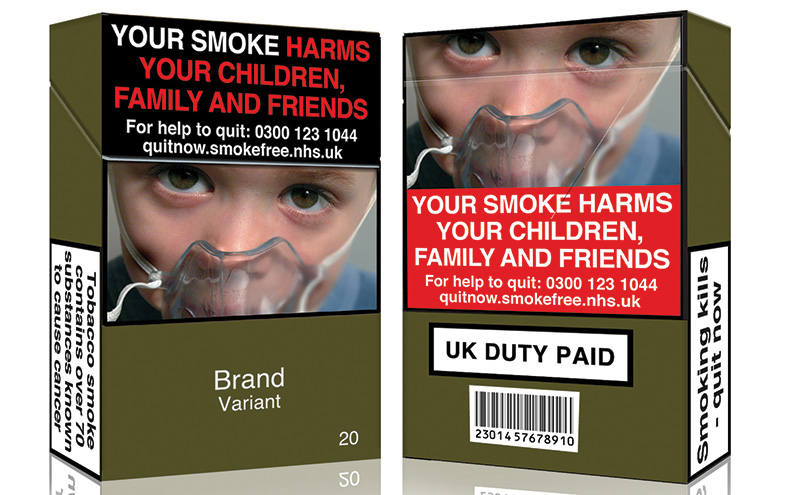AS smokers and tobacco firms come to terms with the new legislation for standardised tobacco packaging in the UK, two individuals with differing views on the matter give Packaging Scotland their take on the potential impact of this dramatic change

Standard cigarette packs spell double trouble for sector
By Mike Ridgway, director of the Consumer Packaging Manufacturers Alliance (CPMA)
THE impact of standardised tobacco packs could potentially be very serious for the packaging sector.
I’m a non-smoker so I’m speaking completely dispassionately about this. We’ve had a series of regulations already – the smoking ban, display ban, vending machine ban. Obviously plain packaging was next on the agenda so the anti-tobacco people have now succeeded in achieving what they wanted and the dangers really are as follows; to start with they are doing away with intellectual property and the branding rights of companies of consumer products. Is that trend going to extend itself? It’s no secret that the regulators are looking now at things like alcohol, fatty foods and sugar.
If you take a cigarette pack, at the moment there are only two companies in the UK that make them. They print them mainly by gravure on big machines, they add value and they enhance the packaging with things like hot-foil stamping, graining, embossing, varnishing. If you move to standardised packs, it’s straightforward lithographic printing. It could even by flexo or digital printing and that opens up a problem, which is the second issue I’m going to point out – the opening up of counterfeiting.
The cigarette packet is a very complex piece of packaging and if you move to a standard print design it is going to make it far easier for people to copy and counterfeit and there is a trend in that direction, certainly in Australia where plain packaging was introduced in 2012.
So, it is a double problem I see for the packaging sector – first of all, will the trend go into other market sectors? And secondly, it will basically take complexity out of the packaging specification, which will make it a lot easier for people to copy and counterfeit.
The thing about packaging for cigarettes is that it is not just the cigarette box. You’ve got pouches, laminates, composite cans, injection mouldings, tins and folding cartons. All the companies involved in this were really little niche specialist businesses and it is very difficult to, for instance, go from producing a cigarette packet on a big gravure machine, making half a million packs an hour, to suddenly start saying ‘let’s find something else to do.’ The market is just not there.
We have a company in Yorkshire called Parkside Flexibles, they’ve laid 35 people off because their business profile now doesn’t allow them to find a market of the same volume and same specification as tobacco, so it is potentially a very serious thing for companies that were involved in the tobacco sector and the challenge for them is to find diversification into a new market and that won’t be easy.
Let’s look at where it has been introduced. It was introduced in Australia in 2012. There were three objectives – to reduce the attractiveness of the product to young people, to enhance health warnings, and to reduce smoking generally. On all three criteria there has been no recorded success. What has also happened is the illicit market has gone up and the latest statistics in Australia are now that over 14% of all cigarettes are from the illicit trade – that’s one cigarette in seven.
I speak for the packaging industry, not the tobacco industry. We’ve always said we don’t mind regulation – everybody acknowledges tobacco is harmful – but if you’re going to have regulation lets have something effective, something we know works. It seems to be a treadmill of regulation.
If you compare the standardised pack to the old ones, they are pretty horrific. There’s no doubt about it, looking at some of those pictures. I don’t think they’re very good but the serious point on this is it does take away from the tobacco companies their branding and intellectual property rights and if that feature becomes established like in, for instance, Scotch whisky, where you’re not allowed to put a brand name on anymore because it might attract youngsters into drinking whisky, think of the effect of that. It could potentially be very, very dangerous and damaging to the packaging manufacturing industry.
I think the best thing that could happen is to educate people and I do think the same principle can be extended to the business of fatty food and sugar. It needs to be a very firm schools programme; it should be part of the educational system.
Tobacco is a legal product, nobody is telling you that you must buy it, nobody is telling you that you should buy it. It generates an enormous amount of tax for the government – 13.5 billion pounds. If suddenly that was denied I don’t know what the Government would do about that but it’s always a consideration and that is always the argument when people say we should just ban it – if you ban it you just set up an underground market anyway and secondly, you have problems on taxation.
The illicit trade in the UK is growing. The profits from dealing in tobacco are enormous and HMRC are saying 2 billion pounds is lost a year to evading VAT and that’s 8 million pounds every day being lost through the illicit tobacco trade so there’s a massive job to be done in that area and plain packaging isn’t going to help.
The for-and-against argument has passed by now, it has become law and that’s it. It’s the implications and the effect of this on the packaging industry that is the concern now. Having worked in the industry for 41 years and it having given me a great deal of pleasure and satisfaction, I would say to my colleagues I just don’t want to see your jobs go down the drain because of this excessive regulation, on which there is no evidence that it’s going to work.
• Mike Ridgway was a senior executive with Chesapeake Corporation and was latterly the managing director of Weidenhammer UK Limited, a major producer of composite cans in Europe.

Plain packs – it’s plain simple!
By Sheila Duffy, chief executive, ASH Scotland
IT will come as no surprise to anyone reading this column that attractive, well-designed packaging can make a product more attractive to consumers. That’s true of food and drinks – the famous trademarked Coca-Cola bottle is just one example – as well as perfumes, with their sleek lines and enticing colours. And until this year, it’s been true of cigarettes.
Cigarette advertising has been heavily restricted in the UK since the Tobacco Advertising and Promotion Act came into force in 2002, and even more heavily since bright, attractive displays in shops were restricted in 2010. Since then, Big Tobacco’s main advertising outlet has been the packs themselves. As one tobacco company executive put it, “when you don’t have anything else – our packaging is our marketing”. And the industry has used clever and unique pack design to devastating effect. Cancer Research UK have shown in detail how attractive current tobacco packaging is to children – an essential market for Big Tobacco, since the majority of smokers start in childhood.
With our Government’s world-leading goal of a tobacco-free Scotland by 2034, it’s essential that we use every tool we have to keep today’s young people from starting smoking.
That’s just what Australia has done. Australia became the first country to introduce plain packaging in 2012. They first restricted the design of plain packs which we’ll be seeing here in the UK. If you’re imagining the blank, white, minimalist packs the tobacco industry often portrays, and thinking that they would be easy to counterfeit and possibly even attractive to young people, don’t be fooled. The truth is that plain packs are ugly. Small text on a muck-green background is the only identifying feature of the brand – with most of the rest of the pack taken up by graphic, visual health messages showing the health consequences of smoking.
And it’s become apparent that those arresting warnings really work. The evidence for plain packaging has gone from compelling to certain in the last few years. Australia’s law was accompanied by a well-funded research programme, letting scientists study the impact of the change in great detail. And what they’ve found is that plain packs have already caused a small but significant decline in the smoking rate. This policy will take time, as it’s focused on the next generation. But already we’re seeing positive effects in this generation.
Tobacco industry supporters often scaremonger about the results of plain packaging. They say that illicit tobacco – smuggled or counterfeit cigarettes and rolling tobacco – will increase, in part because the “simpler” packaging will be simple to copy. But that isn’t borne out by the evidence. In Australia, counterfeiting simply hasn’t happened on any significant scale, partially because the advanced security features and detailed health warnings on Australian packs make them difficult to fake. There’s still the need for capable, professional printers – in fact, now more than ever.
Another common tactic is warning of a “slippery slope”, implying that food or alcohol might soon be subject to similar regulations. But there’s no real comparison between those products and tobacco. There is no other consumer product which, when used as intended by its manufacturers, kills as many as 2 in 3 of its established users. That’s without thinking of the additional harm of second-hand smoke, especially to children. This is an epidemic, particularly among the poorest people in Scotland. And an epidemic like this requires a proportionate response.
Make no mistake, plain packaging won’t single-handedly address the health impacts of tobacco. But as part of a wider strategy, it can help to put tobacco out of sight, out of mind and out of fashion for the next generation, beating an urgent threat to public health.














